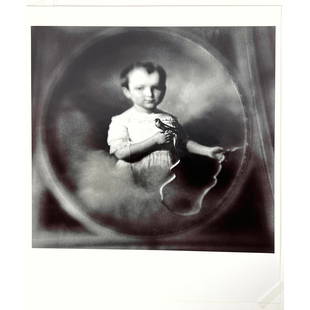

 Weekly: JewelryBonhamsSponsored.Your ad here?
Weekly: JewelryBonhamsSponsored.Your ad here?





 DesignChristie'sSponsored.Your ad here?
DesignChristie'sSponsored.Your ad here?





 DesignChristie'sSponsored.Your ad here?
DesignChristie'sSponsored.Your ad here?




Albert Einstein Signed Unique Patent Assignment
Similar Sale History
View More Items in PhotographyRelated Photography
More Items in Photography
View MoreRecommended Art
View More






Item Details
Description
Albert Einstein Signed Rare Patent Assignment Document, Touching on His Nobel Prize Winning Work of The Photoelectric Effect!
Two page typed Patent assignment, 8.25" x 11" on tissue stock. Dated "December 5, 1936", and signed by both Albert Einstein, "Albert Einstein" and Gustav Bucky "Gustav Bucky". Accompanied by a copy of their patent No. 2,058,562 for a "Light Intensity Self adjusting Camera". Neatly bound in a folder.
The patent was created by Einstein and Bucky, his long-time friend, and is considered the only invention where Einstein used a physical phenomenon, the photoelectric effect, which he had investigated theoretically. Their camera could automatically determine the proper aperture and exposure to take a photograph. This invention for a self adjusting camera came nearly 5 years before Kodak introduced the Super Six-20, (generally known as the first automatic camera), however Kodak's camera operated on a principle different than that of Einstein-Bucky's camera, which could automatically determine the proper aperture and exposure to take a photograph. The purpose and invention of the patent is described as follows:
"This invention relates to a camera with a device for automatically adjusting the light intensity, and an object of the invention is to provide means for automatically adapting the light impinging the photographic plate or film of the camera to the light intensity of the surroundings and particularly of the object to be photographed.
A further object of the invention is to provide means for an automatic adjustment of the light intensity without necessitating the use of a power source which may be due to `get exhausted after a certain length of time, like an electric battery."
This assignment for the consideration of $1.00 sold the patent and all rights to the invention, and patent related damages and profits to the Roefinag Research Corporation. There is documentation that Bucky and Einstein had formulated an agreement with Roefinag Research Corporation that they, as inventor partners, gave the company the right and duty to apply for a patent in Germany for the same device and to promote its exploitation for a share in its profit.', with the likely scenario being that Roefinag had three, and only three trustees: Bucky, Einstein, and Mayer. This would explain why their patent was sold for the sum of only $1.00. One of few patents Einstein obtained, which was his application of science to daily life.
Though Einstein is most famous for relativity, it wasn’t what won him the Nobel Prize in physics. Instead, he was recognized primarily for his explanation of the photoelectric effect. This discovery is so important—and Nobel Prize worthy—because Einstein suggested for the first time that light is both a wave and a particle. This phenomenon, known as the wave-particle duality of light, is fundamental to all of quantum mechanics and has influenced the development of electron microscopes and solar cells. The effect was impossible to understand in terms of the classical wave description of light, as the energy of the emitted electrons did not depend on the intensity of the incident radiation. Classical theory predicted that the electrons would 'gather up' energy over a period of time, and then be emitted.Even before Einstein’s time, scientists had known that exposing certain materials to light could generate an electrical current. But as science writer Sarah Laskow explained in 2014 Atlantic article, they didn’t know why. They thought of light as waves and didn’t see how light could put enough energy into a metal such as selenium for it to give off electrons. In a 1905 paper, Einstein, building on work by Max Planck, came up with a different explanation. What if light behaved like a particle instead of a wave? Each of the particles, or photons, contained some energy, and if the frequency of the particles was high enough, they could transfer enough energy to electrons that they would be ejected away from the selenium atoms. The most obvious application of the photoelectric effect is in solar panels, but it also led to the development of devices that could be triggered by light exposure, or by the interruption of a beam of light—such as those doors that swing open when you walk up to the supermarket. Today's broad use of this theory enables today’s digital cameras to turn images into code that can be read by a computer, among other numerous uses.
This piece sold at Christies 20 years ago.
WE PROVIDE IN-HOUSE SHIPPING WORLDWIDE!
Buyer's Premium
- 25%
Albert Einstein Signed Unique Patent Assignment
Shipping & Pickup Options
Item located in Westport, CT, usPayment


















![Prof. Einstein - a photograph by Zvi Oron [Orushkes]: Albert Einstein - Photo signed with the stamp of photographer Zvi Orushkes. Photographer Zvi Oron [1888-1980], after trying photography in Warsaw and then in the United States, purchased photography e](https://p1.liveauctioneers.com/6868/151594/76529450_1_x.jpg?height=310&quality=70&version=1570528439)









































![Original photograph from the set of Star Wars. 1977. INSCRIBED BY GEORGE LUCAS.: [LUCAS, George (b. 1944)]. Original photograph from the set of Star Wars with personal inscription from George Lucas. 1977. 8 x 10 in. gelatin silver print (masking tape applied to border, presumably](https://p1.liveauctioneers.com/197/329395/177650274_1_x.jpg?height=310&quality=70&version=1715364962)


![Emilio Grau-Sala "Sur la Plage" Oil on Canvas: Emilio Grau-Sala (Spanish, 1911-1975), "Sur la Plage" [On The Beach], Oil on Canvas, 1958, signed "Grau Sala" lower right, signed, inscribed "Trouville", dated, and titled to verso. Image: 21.5" H x 2](https://p1.liveauctioneers.com/5649/328023/176731071_1_x.jpg?height=310&quality=70&version=1714409606)












